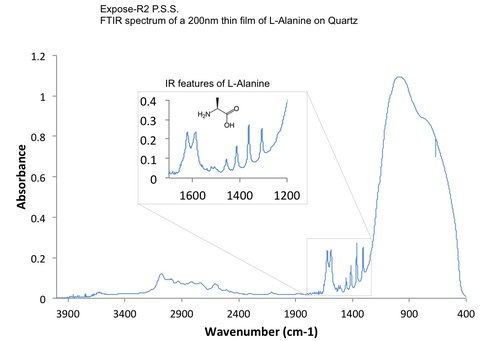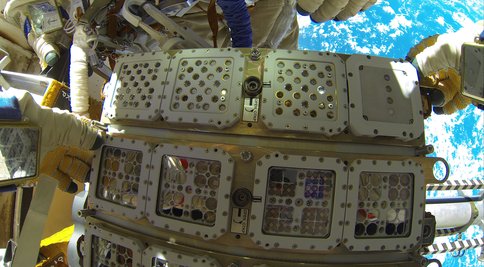2014 Annual Science Report
 University of Wisconsin
Reporting | SEP 2013 – DEC 2014
University of Wisconsin
Reporting | SEP 2013 – DEC 2014
Project 1B: Photostability of Pigments and Amino Acids in Space Environment on the International Space Station
Project Summary
Radiation plays a fundamental role in space environments, planetary systems and on the young Earth where life has emerged ~ 3.6 billion years ago. In order to measure the photostability and photochemical alteration of organic compounds in actual space environments, experiments in Low Earth Orbit (LEO) are crucial to our understanding of potentially destructive effects, particularly from the VUV (vacuum ultraviolet) spectral region. Space-based experiments are conducted in part due to the difficulty of accurately simulating the entire space environment in the laboratory (such as UV radiation, galactic cosmic ray irradiation, microgravity, temperature etc.). In preparation for the EXPOSE-R2 space exposure facility on the International Space Station (ISS) we prepared and investigated thin films of key pigments as well as mineral-associated amino acids for the experiments BIOMEX and Photochemistry on the Space Station that investigate a range of chemical compounds relevant for astrochemistry and astrobiology. The EXPOSE-R2 facility was launched on July 24th, 2014 to the ISS and was activated in November 2014. EXPOSE-R2 will remain in Low Earth Orbit (LEO) for 12-18 months. After retrieval non-destructive as well as destructive analyses will be performed in Earth laboratories to understand the effects of space exposure. We report on the flight preparation of samples and discuss the characteristics of the biomolecule thin-films measured by spectroscopy.
Project Progress
Biomarkers play an important role in the search for extant or extinct life on Earth and beyond. Pigments and amino acids are biomolecules of particular interest because of their functionality and great abundance in life. Organic pigments are essential in the photosynthesis and sometimes protect organisms from the harmful effects of UV radiation. Amino acids are the building blocks of proteins and are therefore also inherent to life. Unlike pigments, amino acids are not as stable when exposed to UV radiation. However, radiolysis is greatly reduced when amino acids are embedded in minerals.
The BIOMEX experiment mainly studies pigments in the form of solid pellets but some cells are reserved for pigment thin films of naringenin, quercetin, parietin and β-carotene. Uniform organic thin films were produced using vapor deposition. Thin film thickness was monitored via a quartz crystal microbalance (QCM). Thin films on D-, L-, or R amino acids were deposited on top of minerals such as quartz or solvent casted homoionic sodium montmorillonite (Na+-MMT) films. Some of the amino acids were prepared intercalated into the clay interlayer.
Pre-flight ultraviolet-visible (UV/Vis) and Fourier transform infrared (FTIR) spectroscopy was performed on the pigments, amino acids and mineral samples (Figures 1 and 2). This non-invasive method provides spectra which can be used as a reference when the samples return from space. The UV/Vis spectroscopy setup was placed inside a glove box so the samples could be measured after deposition without being exposed to moisture.
Ultrathin solid films can exhibit short-range structure in molecular packing that results in solid-state effects that can lead to band quenching, which induces differences in relative band intensities relative to solution-phase spectra. However, when the thin films are washed off they regain their original characteristics, illustrating that the pigments are not chemically altered by the deposition process. We verified that washed off thin film spectra were identical to the spectroscopic properties of pigments measured in solution. Both experiments, BIOMEX and Photochemistry on the Space Station (PSS), are currently exposed on the ISS, see Figures 3 and 4. The BIOMEX samples investigate the photostability of pigments in an attempt to find biomarkers indicative for potentially extinct or extant life on Mars. The PSS samples investigate among others, the photostability of chiral amino acids and the interaction with clay minerals with respect to enantiomeric enrichment. Samples will be retrieved in 2016 from the ISS for further analysis.
Publications
-
Cook, A. M., Mattioda, A. L., Quinn, R. C., Ricco, A. J., Ehrenfreund, P., Bramall, N. E., … Walker, R. (2014). SEVO ON THE GROUND: DESIGN OF A LABORATORY SOLAR SIMULATION IN SUPPORT OF THE O/OREOS MISSION. The Astrophysical Journal Supplement Series, 210(2), 15. doi:10.1088/0067-0049/210/2/15
-
Cook, A. M., Mattioda, A. L., Ricco, A. J., Quinn, R. C., Elsaesser, A., Ehrenfreund, P., … Hoffmann, S. V. (2014). The Organism/Organic Exposure to Orbital Stresses (O/OREOS) Satellite: Radiation Exposure in Low-Earth Orbit and Supporting Laboratory Studies of Iron Tetraphenylporphyrin Chloride. Astrobiology, 14(2), 87–101. doi:10.1089/ast.2013.0998
-
Demets, R., Bertrand, M., Bolkhovitinov, A., Bryson, K., Colas, C., Cottin, H., … Schuster, M. (2014). Window contamination on Expose-R. International Journal of Astrobiology, 14(01), 33–45. doi:10.1017/s1473550414000536
-
Ehrenfreund, P., Ricco, A. J., Squires, D., Kitts, C., Agasid, E., Bramall, N., … Young, A. (2014). The O/OREOS mission—Astrobiology in low Earth orbit. Acta Astronautica, 93, 501–508. doi:10.1016/j.actaastro.2012.09.009
-
Elsaesser, A., Quinn, R. C., Ehrenfreund, P., Mattioda, A. L., Ricco, A. J., Alonzo, J., … Santos, O. (2014). Organics Exposure in Orbit (OREOcube): A Next-Generation Space Exposure Platform. Langmuir, 30(44), 13217–13227. doi:10.1021/la501203g
-
Goesmann, F., Raulin, F., Bredehöft, J. H., Cabane, M., Ehrenfreund, P., MacDermott, A. J., … Ulamec, S. (2014). COSAC prepares for sampling and in situ analysis of cometary matter from comet 67P/Churyumov–Gerasimenko. Planetary and Space Science, 103, 318–330. doi:10.1016/j.pss.2014.08.006
-
Michel, P., Barucci, M. A., Cheng, A. F., Böhnhardt, H., Brucato, J. R., Dotto, E., … Agnolon, D. (2014). MarcoPolo-R: Near-Earth Asteroid sample return mission selected for the assessment study phase of the ESA program cosmic vision. Acta Astronautica, 93, 530–538. doi:10.1016/j.actaastro.2012.05.030
-
PROJECT INVESTIGATORS:
-
PROJECT MEMBERS:
Pascale Ehrenfreund
Project Investigator
Andreas Elsaesser
Co-Investigator
-
RELATED OBJECTIVES:
Objective 3.1
Sources of prebiotic materials and catalysts



